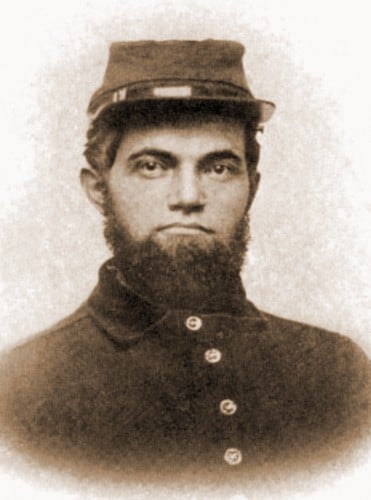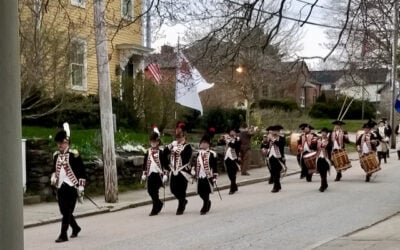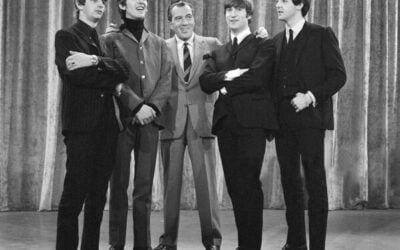Above: Alfred Gardner’s bible he had in his pocket as he bled to death at the Battle of Gettysburg.

Alfred G. Gardner
When you walk through the Varnum Armory Museum there can be a feeling of sensory overload . . . your eyes go to the weapons . . . the beautiful historic flags . . . and on to our colorful collection of 19th century uniforms. It is easy to miss one of the most epic and solemn objects in our collection: a small, well-worn black leather-bound pocket bible with the name, “Alfred G. Gardner” embossed on the cover.
Alfred G. Gardner had recently moved his family from Swansea, Mass., to Providence when the Civil War broke out in April 1861. While thousands of Rhode Islanders hurried to enlist, Alfred struggled over the thought of leaving his beloved wife and five children home alone on the one hand, and serving his country and God, on the other. He wrestled over the decision for a few months. Being a patriot and religious man, he ultimately decided it was his duty to serve, regardless of the cost.
Alfred enlisted in Battery B, 1st Rhode Island Light Artillery, at the Benefit St. Arsenal in August of 1861. He carried the bible in the pocket of his sack coat every day of the war. And he used the bible as a sort of diary, writing little messages in pencil in the margins of the pages. These were mostly written to his children – words of advice and wisdom, emotionally charged stuff.
He was a witness to every major battle in the Eastern theater of the Civil War, up until the Battle of Gettysburg. In late June of 1863, General Robert E. Lee and his Confederate Army invaded south-central Pennsylvania. The two armies would meet at the small crossroads town of Gettysburg on July 1. In all, 170,000 Americans ferociously fought each other over a three-day period. By the end of the battle, over 52,000 Americans had been killed, wounded or were missing. It was the biggest and one of the most pivotal battles of the entire war.
On the third day of that battle – July 3 – Alfred and his battery were right in the center of the Union line. On that day, General Lee decided to mass his army and attack Alfred’s position. Preceding the attack, most of Lee’s artillery – about 130 guns spread across a 2-mile front – began firing at 1 p.m. that afternoon right at Alfred’s position. The hour-long barrage was described as being the loudest event in human history up until that point in time. The men said the ground literally shook. The sound of the guns could be heard from as far as Harrisburg, about 39 miles away.
It was during this bombardment that Battery B began to return fire. Alfred as Gunner #2 reached over the carriage and took a cotton bag of gunpowder and was turning to insert it into the cannon tube when at that moment a Confederate artillery shell from 2 miles away arched over the field and came down striking the muzzle of Alfred’s cannon. The explosion instantly killed gunner #1, William Jones, just a few feet away from Alfred. Alfred had his left arm nearly severed just below his shoulder. He went down on his back. He was bleeding to death.

Albert Straight
His best friend, Albert Straight, who was the sergeant of the gun, bent down to him. They clasped their hands together. Alfred’s first words were, “Please tell my wife I died happy.” And then he said, “Please make sure she gets my bible.” Albert says they bid farewell and he turned away from him and then heard Alfred yell out in a loud and clear voice, “GLORY BE TO GOD. HALLELUJAH! AMEN AMEN!” and then died.
The next day, July 4, Albert – perhaps emotionally unable to do it himself – asked one of his men to go to Alfred and retrieve his bible. They dug a hole in front of their guns and buried the two men in the same hole and marked their grave with their names. You see, Alfred had a premonition that he would not survive this battle and he had earlier asked his men to mark his grave so he could be found by his family.
A letter was found at the R.I. Historical Society in 2010 written by his brother where he stated he went to Gettysburg two weeks after the battle, found his brother’s grave, dug him up if you can imagine, and brought him home to Swansea where he was eventually buried with other family members.
Now when you read the inscriptions he wrote for his children in his bible, you completely understand why he used his last gasping words to ask for it to be sent home. I’ve seen the last inscription, written the day before he died, with my own eyes…in pencil it says:
“July 2nd 1863. Gettysburg. In battery all ready for action. I am well in body and my mind is clear about the future. The thought of heaven has cheered me on this march from Falmouth to Pennsylvania. . . . CHILDREN! Always be of good cheer. And ALWAYS do right. This is the wish of your father.”
That was the last thing he wrote to them.
Albert would write Alfred’s wife a letter explaining the details of his death and send along his bible, the same bible that is now on display at the Varnum Armory Museum in our 19th Century room.
Alfred’s widow would later refer to the bible as a “treasure.” It is, indeed, an historical treasure – a powerful symbol of the devotion, courage, selflessness, and ultimate sacrifice made by thousands of Rhode Islanders in the War to end slavery and preserve the union of our country.

The actual cannon that Alfred was manning when killed is on display today at the RI State House.
Patrick Donovan lives with his wife, Anne, in the Hill District of East Greenwich. He is the director of the Varnum Memorial Armory Museum where he is responsible for the care of the museum collection, the conservation lab, and facility. He works as a project manager and senior research analyst for Schneider Electric’s Energy Management Research Center.






 Subscribe
Subscribe
Do you know where Gardner is buried ? I would like to visit his grave next Memorial Day.
His grave is missing and we are working to find it.